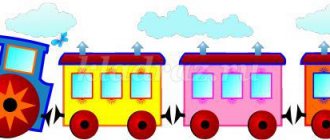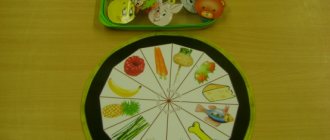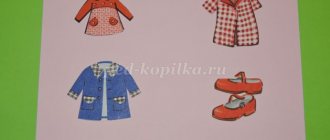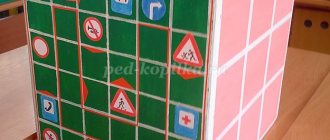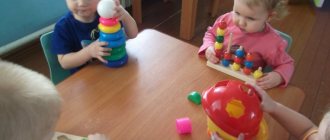methodological development “didactic games”
A person cannot develop a comprehensive understanding of the surrounding objective world without tactile-motor perception
, since it underlies sensory knowledge. Games for recognizing objects by touch: “Find your toy in a bag”, “Wonderful bag.”, work with tactile dies (mnemonics), Montessori - exercise “Rough figures”.
For the development of auditory perception
use didactic games - “Who called?”, “Where is it ringing?”, “Who is there?”. Correctly determining the direction where the sound is coming from helps you navigate in distant space, determine your location, and the direction of movement. Musical sounds have a huge impact on the development of the child’s emotional sphere and on his aesthetic education.
In the game the following are formed and most effectively developed:
Creative imagination, imaginative thinking, favorable conditions are created for the transition from visual-effective thinking to figurative thinking and to elements of verbal-logical thinking. Ability to make judgments and inferences (
basic tools of thinking), the ability to apply their knowledge in different conditions.
Voluntary attention and memory, a subordination of motives and purposefulness of actions develops.
Speech.
It is in the game that the ability to voluntarily, on one’s own initiative, submit to various requirements is initially manifested.
The process of learning about one’s capabilities (self-awareness) and the capabilities of a peer; allow children to be introduced to socially useful ways of self-affirmation
Play creates a “child’s zone of proximal development.” L. S. Vygotsky
Various forms of voluntary behavior in children
Aesthetic education
Formation of children’s aesthetic attitude towards the environment
Formation of artistic skills in the field of various arts: teaching children drawing (“Decorate a toy with a Dymkovo pattern,” “Russian folk costume”), modeling, singing, movements to music, development of verbal creativity.
Living in beauty, noticing beauty, supporting and creating beauty around you - these make everyday life aesthetics
a means of aesthetic education.
Formation of a child’s ecological culture
Didactic material must meet hygienic and aesthetic requirements: toys must be painted with bright colors, artistically decorated, and placed in boxes and folders that are convenient for storage. Bright, beautiful educational toys attract children's attention and make them want to play with them. All material for didactic games is stored in the group in a certain place accessible to children for its use.
Moral education.
A special place in working with preschoolers is occupied by didactic games, which foster good feelings for play partners and the desire to provide basic assistance. The rules of the game create norms of behavior, define correct relationships, foster feelings of collectivism, and the ability to yield to peers. Conscientious implementation of the rules teaches honesty and justice. In collective games, children develop a sense of social dependence, the ability to take into account not only their own interests, but also the interests of others, and “sacrifice personal benefits for the sake of the common good.” . Games also reveal the child’s character traits that can serve as an example for others: camaraderie, responsiveness, modesty, and honesty. Ideas are formed about caring for objects around them, toys as products of adult labor, about norms of behavior, about relationships with peers and adults, about positive and negative personality traits.
Methodology for organizing didactic games in different age groups.
Methodology for organizing didactic games in different age groups.
Outdoor games in working with preschool children. Classification of outdoor games and their characteristics. Carrying out finger games with preschool children
Main types of games.
All didactic games can be divided into three main types:
v games with objects (toys, natural materials),
v desktop-printed
v word games.
Games with objects.
Playing with objects uses toys and real objects. By playing with them, children learn to compare, establish similarities and differences between objects. The value of these games is that with their help children become familiar with the properties of objects and their characteristics: color, size, shape, quality. In games they solve problems of comparison, classification, establishing sequence in solving problems. As children master new knowledge about the subject environment, the tasks in the games become more complicated: the children practice identifying an object by any one quality, combine objects according to this characteristic (color, shape, quality, purpose, etc.), which is very important for the development of abstract , logical thinking.
early and junior preschool groups are given objects that differ sharply from each other in properties, since kids cannot yet detect subtle differences between objects.
In the middle group , they use items in which the difference between them becomes less noticeable. In games with objects, children perform tasks that require conscious memorization of the number and location of objects, and finding the corresponding object. While playing, children acquire the ability to put together a whole from parts, string objects (balls, beads), and lay out patterns from various shapes.
games with natural materials (plant seeds, leaves, various flowers, pebbles, shells) when conducting such didactic games as “Whose children are these?”, “Which tree is the leaf from?”, “Collect a bouquet of autumn leaves,” and etc. The teacher organizes them during a walk, directly in contact with nature. In such games, children’s knowledge about the natural environment around them is consolidated, mental processes are formed (analysis, synthesis, classification) and a love for nature and a caring attitude toward it are fostered.
Games with objects include plot-didactic games and dramatization games. In the plot-didactic game, children play certain roles, the seller, the buyer in games like “Shop”, etc. Dramatization games help clarify ideas about various everyday situations, literary works “Journey to the Land of Fairy Tales”, and norms of behavior “What is good and what is bad?
Board-printed games.
Printed board games are a fun activity for children. They are varied in type: paired pictures, lotto, dominoes. The developmental tasks that are solved when using them are also different.
Selection of pictures in pairs. The simplest task in such a game is to find exactly the same ones among different pictures: two hats, identical in color, style, etc. Then the task becomes more complicated: the child combines the pictures not only by external features, but also by meaning: find two airplanes among all the pictures. The planes shown in the picture may be different in shape and color, but they are united by belonging to the same type of object, making them similar.
Selection of pictures based on common characteristics. Some generalization is required here, establishing connections between objects. For example, in the game “What grows in the garden (forest, city)?” Children select pictures with corresponding images of plants, correlate them with their place of growth, and combine the pictures according to one feature. Or the game “What happened then?”: children select illustrations for a fairy tale, taking into account the sequence of the plot.
Memorizing the composition, quantity and location of pictures.
For example, in the game “Guess which picture was hidden,” children must remember the contents of the pictures, and then determine which of them was turned upside down. This game is aimed at developing memory, memorization and recall. The gaming didactic tasks of this type of games are also to consolidate children’s knowledge of quantitative and ordinal counting, the spatial arrangement of pictures on the table, and the ability to talk coherently about the changes that have occurred with the pictures and their content.
Making cut pictures and cubes.
The purpose of this type of games is to teach children logical thinking, to develop their ability to form a whole object from individual parts. In groups of early and junior preschool age, pictures are cut into 2-4 parts, then in middle and older groups the whole is divided into 8-10 parts. At the same time, for the play of children of early and junior preschool age, one object is depicted in the picture: a toy, a plant, items of clothing, etc. For older children, the picture depicts a plot from familiar fairy tales, works of art familiar to children.
Description, story about the picture showing actions and movements. In such games, the teacher sets an educational task: to develop not only children’s speech, but also imagination and creativity. Often a child, in order for the players to guess what is drawn in the picture, resorts to imitation of movements, or imitation of the movements of an animal, its voice. In older groups, more complex problems are solved: some children depict the action depicted in the picture, others guess who is depicted in the picture, what people are doing there, for example, firefighters putting out a fire, sailors sailing on the sea, builders building a house, etc. In these games, such valuable qualities of a child’s personality, such as the ability to transform, to creative search in creating the necessary
image.
Word games.
Verbal games are built on the words and actions of the players. In such games, children learn based on existing ideas about objects, and their knowledge about them deepens. Children independently solve various mental problems; describe objects, highlighting their characteristic features; guess from the description; find signs of similarities and differences; group objects according to various properties and characteristics.
These didactic games are carried out in all age groups, but they are especially important in older preschool age, as they help prepare children for school: they develop the ability to listen carefully to the teacher, quickly find an answer to the question posed, accurately and clearly formulate their thoughts, and apply knowledge in accordance with with the task at hand.
For ease of use of word games in the pedagogical process, they can be conditionally divided into four groups.
v Games with the help of which they develop the ability to identify the essential features of objects and phenomena: “Guess it?”, “Shop”, “Yes - No”, etc.
v Games used to develop children’s ability to compare, contrast, and make correct conclusions: “Similar - not similar,” “Who will notice more fables?”
v Games that help develop the ability to generalize and classify objects according to various criteria: “Who needs what?”, “Name three objects,” “Name them in one word,” etc.
v Games to develop attention, quick wits, quick thinking, endurance, sense of humor: “Broken Phone”, “Paints”, “Flies - Doesn’t Fly”, etc.
Didactic task.
To select a didactic game, it is necessary to know the level of preparedness of students, since in games they must operate with existing knowledge and ideas. When defining a didactic task, it is necessary, first of all, to keep in mind what knowledge and ideas of children about nature, about surrounding objects, about social phenomena) should be acquired and consolidated by children, what mental operations should be developed in connection with this, what personality qualities in connection this can be shaped by the means of this game (honesty, modesty, observation, perseverance, etc.).
For example, in the well-known game “Toy Store” the didactic task can be formulated as follows: “To consolidate children’s knowledge about toys, their properties, purpose; develop coherent speech, the ability to identify essential features of objects; cultivate observation, politeness, and activity.” Such a didactic task will help the teacher organize the game: select toys that are different in purpose, material, appearance; give a sample description of the toy, polite address to the seller, etc.
Each didactic game has its own learning task, which distinguishes one game from another. The teacher must know in advance and determine the didactic task accordingly. So the game “What has changed?” use for memorization exercises, “Toy Store” - for the development of thinking, “Guess what you have in mind” - observation, attention.
Game actions.
A didactic game differs from game exercises in that the implementation of game rules in it is directed and controlled by game actions. For example, in the game “Does it happen or not?” the rules of the game require: notice in the poem “Is this true or not?” L. Stancheva all fables:
It's a warm spring now, the grapes are ripe here. A horned horse jumps in the snow in a summer meadow. In late autumn, the bear likes to sit in the river. And among the branches, ha-ha-ha, the nightingale sang. Quickly give me an answer - is this true or not?
But to make the game more interesting and all the children to be active, the teacher introduces a game action; the one who noticed the fable while reading the poem puts a chip in front of him. There are six fables in this poem. This means the winner will have six chips. They will receive a prize.
Game rules.
The main purpose of the rules of the game is to organize the actions and behavior of children. Rules can allow, prohibit, or prescribe something for children in a game, making the game entertaining and tense. Compliance with the rules in a game requires children to have a certain amount of willpower, the ability to deal with peers, and to overcome negative emotions that appear due to a negative result. It is important, when determining the rules of the game, to place children in conditions under which they would receive joy from completing the task. Using a didactic game in the educational process, through its rules and actions, children develop correctness, goodwill, and self-control.
Result
The result of a didactic game is the solution of gaming and didactic problems. Solving both problems is an indicator of the effectiveness of the game.
A group of games with objects.
a) - games with sticks (matches, twigs) where children are asked to make a drawing from sticks with a gradual complication of the task: • complete the pattern after laying it out for adults; • according to the final result (sample); • according to a reduced scheme; • according to verbal instructions; • laying out letters and numbers from twigs. Dear colleagues, let’s post a drawing according to verbal instructions (if a master class for parents, then according to a reduced diagram).
b) finger games with a pencil (preferably a hexagonal one, as it additionally massages the fingers and palm), where children can be offered the following tasks (tasks to be completed by teachers and parents) • roll the pencil between the palms of both hands - from the tips of the fingers to the base of the palm; • roll the pencil with the pads of two fingers (thumb and index, thumb and middle, thumb and ring), alternately with the right and left hand; • roll the pencil between the corresponding fingers of both hands in turn (between the index finger of the right hand and the index finger of the left hand, etc.); • alternately roll the pencil on the table with the fingers of both hands; alternately roll two pencils on the table with the fingers of both hands.
c) games and exercises using small objects and natural materials, where you can use the following task options: • stringing on wire, lace
the required number of beads, balls, buttons according to the demonstration of the action, according to the sample, according to the design of the pattern, according to verbal instructions; making beads (stringing beads of different colors in a certain sequence); • sorting small items (beads, buttons, coins, peas, grains, etc.); the child needs to arrange objects into groups, moving them with his fingertips on the table or grasping objects with two fingers of the right (or left) hand alternately (thumb and index, thumb and middle, etc.); game "Cinderella"; • squeezing and unclenching small rubber toys (hedgehog balls, cylinders with various spikes) with one hand, fingers of one hand; with both hands simultaneously or alternately; • rubbing the palms with walnuts (massage of the palms, including the back side); • rolling walnuts on the table with one hand (two hands); • transferring small objects (beans, peas, buttons, beads, mosaics) from one container to another; the object is grasped alternately with two fingers; complication - grabbing two or three objects at the same time; • folding pyramids, nesting dolls, and any prefabricated toys; inserting molds into one another; selecting lids for various containers; • stringing rings onto a braid or rod; • finger theater; • laying out letters, numbers, and various designs from cereals, buttons, beads; • “drawing” pictures with cereals, beads, seeds, tree leaves.
Methodology for organizing didactic games in different age groups.
How do educational games help you learn mathematics?
Using this type of games in teaching mathematics at preschool age allows you to understand some complex mathematical concepts. Through a visual and simple explanation of simple things, the child begins to relate certain terms to actions or objects.
- Form an idea of the relationship between numbers and numbers, their quantity and spelling. The child must clearly understand how many objects correspond to each number. Being able to measure a drawn symbol makes it easier to understand the principles of arithmetic;
- Orientation in time and space develops. By gaining new experience, viewing objects from different angles, the child learns to understand and perceive abstract concepts;
- In the process of play, through the constant result of certain actions, the child learns to draw conclusions. Allows you to attract the child’s attention to those subjects that do not interest him in everyday life.
- The development of thinking and mathematical abilities allows the child to see new and interesting things in the material already studied;
- Through emotional perception, interest in learning is instilled, which is an important factor in further education at school.
Any activity can be transformed into a didactic game. It is necessary to add some elements of play behavior and invite the child not to study, but to play. During the game, introduce new terms and concepts, displaying them with action.
What types of didactic games are used to study mathematics?
1. To study the account; 2. Orientation in space; 3. With geometric shapes; 4. Games for logic and development of mathematical thinking.
What role do didactic games play in mathematical abilities?
Due to the fact that in didactic games, various objects are studied through folding, sorting and disassembling objects, the child remembers shapes, sizes, colors, etc. He begins to associate the named objects with their image.
Solving the problem posed in the game requires the child to apply existing knowledge and stimulates vigorous activity. Having achieved a result, he enjoys the game and consolidates a positive attitude towards the material studied.
At a subconscious level, the child develops an understanding that solving a problem requires some effort.
The need to concentrate and think through the material to obtain the correct answer develops attentiveness and observation in the child. The state of searching for an answer expands the child’s inner world and has a positive effect on his overall development.
During the game, mathematical foundations are formed in an easy, familiar form for the child. The knowledge gained in this way becomes part of the baby and quickly begins to be used by him in everyday life.
Games for learning geometric shapes and counting form basic concepts and allow you to remember the necessary information. Learning to count for a child who has played with numbers is easier, since he has already learned the basics of this knowledge on a subconscious level.
Didactic game as a teaching method in modern primary school
Didactic game as a teaching method in modern primary school
The key to the successful development of modern society is the formation of an independent, thinking person. Education can solve this problem if it is based on the principles of humanism, individualization and sociocultural openness, as well as on the principle of the intrinsic value of each age.
The traditional education system is changing; within its framework, variable courses, new academic subjects, programs, etc. appear, the authors of which are trying to expand ideas about the goals of modern primary education. At the same time, the priority of primary school goals remained unchanged for many years. The main, and sometimes the only conscious goal was teaching a specific subject, equipping students with a sum of knowledge and skills. It was assumed that the implementation of such a goal would itself provide a solution to the problem of child development. But that's not true.
Training in which development tasks are not specifically planned does not always produce a developmental effect. “Development is a result that does not coincide with its content.”
This means that learning outcomes cannot be measured only by the content of the programs being studied; it is necessary to evaluate the changes that have occurred in the mental development of the student and in his ability to learn. What is development?
- Development is not the amount of knowledge that a student has received, but the ability to use it and apply it in a variety of independent activities (including in non-standard situations). For example: A student can not only talk about the properties of water by retelling the textbook text, but also determine the properties of snow and ice and fill out the corresponding table.
2. Development is not the presence of knowledge, but the ability to obtain it.
Everyone is well aware of the following fact: schoolchildren know how to read, but do not like to read. Starting from the 2nd grade, reading becomes a general academic skill, but, unfortunately, it is not often used by schoolchildren for self-education, to “acquire” new knowledge. There are many reasons for this, but one of the most important is that schools most often offer students knowledge in a ready-made form and do not teach students the skills of independent cognitive activity.
3. Development is not the presence of knowledge, but the ability to determine one’s ignorance.
Educational activity is impossible if the student does not have developed monitoring and evaluation activities.
Reconsidering the view of subject knowledge and skills does not in any way diminish their role in the student’s educational activities. The point is only that from the goals of education they become a means and result of the pedagogical process.
We must understand that the most important and appropriate tasks are those related to ensuring the development of the student, taking into account his age-related capabilities. Adult participants in the educational process often lose sight of the fact that a child who comes to school has not yet become a real student in his development. He is, as it were, at a transitional stage from preschool age, where all new personal qualities are formed more easily and best in play activities, to primary school, where educational activities become the leading activity.
Learning activity is understood, first of all, as activity that has as its content the mastery of generalized methods of action. The result of educational activities is a change in the student himself, his development.
At the same time, play remains a very important activity. It is she who helps to form a new leading activity - educational. We are talking, first of all, about a didactic game.
The structure of such a game presupposes the presence of a didactic goal, game rules and actions. Games with rules have a learning problem that must be solved. It combines play with learning and the same method of action that a schoolchild uses, for example: classification, comparison, analysis, etc. Playing with rules, just like educational activities, necessarily produces results, develops self-control and self-esteem. Thus, the components of educational activity largely coincide with the components of a didactic game with rules.
However, in order for the game to become a teaching method, the following conditions must be met.
— The educational task must coincide with the game one.
— The educational task should not “crush” the game task; it is important to preserve the game situation.
- A single game does not provide any learning effect, so a system of games with an increasingly complex learning task must be built.
Thus, the didactic game becomes a teaching method that ensures the full realization of the possibilities of the child’s age and the formation of educational activities in the primary school student.
Options for didactic games
You can use any objects and toys in educational games. You can use a ready-made version or play without additional material. For example, invite your child to show the number using his body or mold it from plasticine.
It is important to understand that a didactic game provides a whole range of new knowledge and skills, based on previously gained experience. For example, while studying numbers, you can additionally repeat shapes and colors. Using a child’s experience is an excellent option for developing imaginative and logical thinking. The formation of associations and connections between various objects has a beneficial effect on the overall development of the child.
Games for 1-2 years
For children of this age, you can offer games for the development of fine motor skills, logical development and primary mathematical operations. For example, building towers from cubes, rearranging and dividing according to the characteristics of various objects.
A didactic game is one of the most popular ways to teach a child mathematical skills in preschool age. The opportunity to use options for such activities from a very early age provides an incentive for development in all areas of knowledge.
Children of this age can be offered the following options:
- Invite your child to make a pyramid from one type of cubes, and build a pyramid of a different style yourself. Compare the result. When building a pyramid, hone your understanding of a variety of subjects;
- Inserts and various logic houses and cubes;
- Exercises with balls. They are sorted by color and size.
- Game "what's in the bag". Place objects that are familiar to the child in a thick bag and ask them to guess what the child got into his hands. As you get older, you can suggest getting something of a certain shape.
Games for children 3-4 years old
- To select missing parts. You can buy such a game, or you can make it yourself. Cut out an object known to the child (a house, a train) from paper or cardboard. Make holes of different shapes and invite the child to pick up the missing parts;
- Collect beads from various materials with your child;
- Prepare large multi-colored shapes of objects. Using the same color, prepare smaller copies of the same color. Invite your child to distribute small parts among large ones;
- Teach your child to play with mosaics;
- Matching games for matching parts. You can invite your child to match the lids to a row of pots;
- Make the game "What's in the Bag" more difficult. Let the baby sort the items without taking them out of the bag;
- You can start using board games;
- Collect puzzles and cut-out pictures. To consolidate the count, number the parts of the cut picture and assemble them in order.
- While walking on the street, encourage your child to count items and objects;
Games for children 5-6 years old
- A variety of board and floor games;
- Finding suitable parts of objects;
- Construction from various materials and shapes;
- Creating items for games. Invite your child to help you prepare the pieces for the new game. You can cut out shapes of a given color and size, draw the necessary cards, etc.;
- Fantasizing about a new game.
Didactic games are a good way not only to develop mathematical abilities, but also to strengthen the ability to count. The use of this option for teaching a child is used for teaching other subjects.
It is optimal to present information in a playful way to children under 7 years of age.
Try playing with your child and you will notice how quickly he will learn new skills and acquire the necessary knowledge. If you liked the article, please share a link to it
The concept and functional purpose of a didactic game
Definition 1
A didactic game is a method of organizing the educational process, focused on enhancing cognitive activity by influencing the child’s emotions and intellect, in order to achieve his comprehensive personal development.
Figure 1. Didactic game. Author24 - online exchange of student work
A didactic game helps in the implementation of educational programs at different levels, through more effective acquisition of knowledge and the acquisition of new skills in a fun and interesting way for the child.
Through the use of didactic games, independence skills are developed and the basics of social interaction are learned.
The purpose of creating a didactic game is to create conditions in the educational process for the child’s full education, i.e. mastering the educational program and acquiring useful labor and social skills in a non-standard form.
Play is an important activity for preschool and primary school children. Some elements of the didactic game find current application in secondary school. Playful activities help the child relax and not think about the fact that he needs to assimilate information that he does not want. In play, a child enjoys learning something new without even noticing it.
Finished works on a similar topic
- Course work Didactic game as a method of developmental education 450 rub.
- Abstract Didactic game as a method of developmental education 260 rub.
- Test paper Didactic game as a method of developmental education 220 rub.
Receive completed work or specialist advice on your educational project Find out the cost
The didactic game is structured in such a way that its use has the proper educational and developmental effect. It is a way of building the life activities of children in an educational institution. This is realized due to the fact that the content of didactic games is endowed with an emotional component. It is interesting to the child, which activates his desire to participate in the game action. The game is easy and accessible for children's perception. Both individual children, their groups, and the entire children's team can take part in it. The child feels free from any boundaries, activates his imagination, and opens up to other participants in the game. In this way, a gradual, smooth and productive educational process is realized.
Figure 2. Didactic game. Author24 - online exchange of student work
Too lazy to read?
Ask a question to the experts and get an answer within 15 minutes!
Ask a Question
The functional purpose of the didactic game is reduced to performing the following functions:
- Educational.
- Cognitive.
- Developmental.
- Motivational.
- Problematic.
- Explanatory.
These functions reflect, first of all, the only significant goal of using a didactic game - the comprehensive development of the child’s personality. The game contains enormous educational potential, helps to understand the world, develops thinking, logic, physical and mental properties of the individual, promotes socialization, self-determination and self-affirmation of the child. Playful activity motivates children to learn, stimulates search activities - searching for information to solve a problem, helps in understanding and understanding the structure of the world, the functioning of its processes and phenomena.
